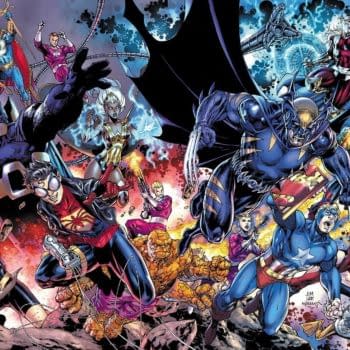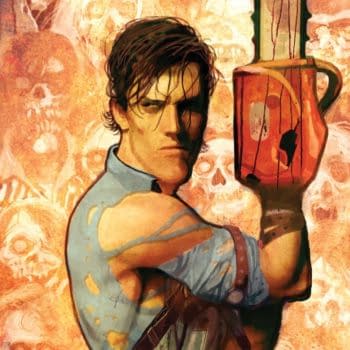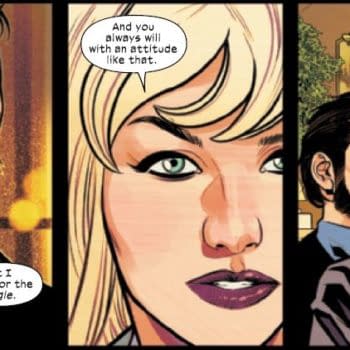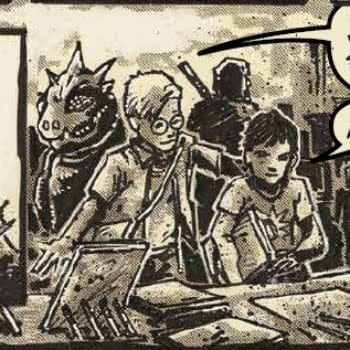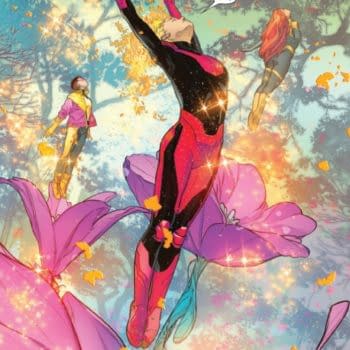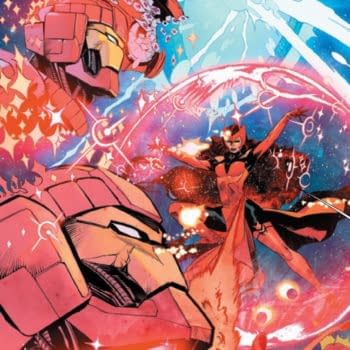Posted in: Comics, Recent Updates | Tagged: cameron stewart, chuck palahniuk, Comics, dark horse, Fight Club 2
'Comics Will Become A Lasting Aspect Of My Output' – Chuck Palahniuk Talks Fight Club 2, Plus Preview
This week on Wednesday, May 27th, the first issue of Fight Club 2 arrives from Dark Horse. The anticipation for this project began last San Diego Comic Con, or arguably, it began the moment author Chuck Palahniuk published the novel Fight Club in 1996.For devotees, a sequel is almost beyond their joy threshold, but for comic readers who are also fans, we hit the jackpot. We've a really in-depth interview on the site with artist on the series Cameron Stewart, and we have a special feature interview with David Mack on the process art and his covers for the series in the upcoming SDCC issue of Bleeding Cool Magazine #17 out in late June, but today we complete the triad by talking with Chuck Palahniuk himself. Needless to say, it is a very great honor to have him here on Bleeding Cool.
[Chip Zdarsky (Books-A-Million variant)]
What readers should keep in mind about Fight Club 2 is that it picks up from the novel's original ending rather than from the ending of the David Fincher film, though fans of the film will certainly find plenty to engage them in the comic. The "bridge" between the novel's ending and this series can be found in Dark Horse's Free Comic Book Day offering. We meet the "narrator" of Fight Club named as Sebastian, 8 years on from the events of the novel, married to Marla, and living with their young son. The premise of the beginning of the series is that Marla misses Tyler Durden's influence and verve in her life and seems bent on opening a definitive can of worms that could have explosive consequences.
Chuck Palahniuk chose to write the Fight Club sequel in the comics medium specifically, and spent a great deal of time studying the medium to learn its modes of expression. He joins us today to talk about Fight Club's new incarnation, some of the ideas behind the sequel, and his experiences in the comics medium.
[Tim Seeley (Chicago Comics variant)]
Hannah Means-Shannon: Why do you think people read stories in prose or comics format particularly, and especially stories featuring shocking or outrageous characters or events?
Chuck Palahniuk: For me the experience is all about the pacing. Comics aren't burdened by the verbose tonnage of words novels use to bridge between important plot points. That's always been my gripe about long-form fiction, and the flaw might date from the time when writers were paid by the word. In response I've always experimented with non-fiction forms which would allow me to jump or cut directly from one important detail to the next. Using choruses, for instance the 'rules' in Fight Club, I could create a non-linear montage of mini-scenes that didn't confuse the reader. Getting back to comics, they already have the filmic panels which move the reader along with minimal effort. It's maximum payoff for the reader's effort.
HMS: When you create characters, do you develop them to a degree that they are "real" to the extent that all the small details of personality and behavior exist for you? And if so, is Fight Club 2 essentially about the very same Tyler Durden and Marla, and Narrator, but just appearing in a new format? Or do you feel the format itself changes them?
CP: Critics of the original 'Fight Club' novel claimed the characters were flat and two-dimensional. In other words, "cartoonish." A complaint also lodged against Cameron Stewart's style. I embrace such judgments. We live in an era mired in "dirty realism" or "K-Mart realism" and while I enjoy the stories of Raymond Carver and Tobias Wolff and Joyce Carol Oates, I do not want to write them. So-called "cartoonish" characters can also be read as mythic. Odin, Coyote, Raven, Zeus, The Bible, they're all unrealistic, but they depict human behaviors in an epic, more-engaging way. I'd rather err on the operatic side of Ayn Rand and create a compelling story that doesn't seem dated a year after publication.
[David Mack Variant Cover]
HMS: Was the idea, initially, that you felt you wanted to work in the comics medium, and so eventually settled on doing a sequel to Fight Club, or that you wanted to do a sequel, but weren't sure of the medium until you settled on comics? Or another approach entirely?
CP: The thriller writer Chelsea Cain played midwife to this project. She invited me to dinner with Matt Fraction and Brian Bendis, and from the moment the discussion began, it focused on depicting 'Fight Club' in comic form. The medium and the subject were linked from conception.
HMS: What does it bring to your life creatively to face and address the challenge of thinking in a new medium? Does it have value to you that failure is possible?
CP: The concept of 'failure' doesn't exist for me. Nothing is a total loss until I choose to give it up, and I'm one of those people who love to recite the long litany of disasters and rejections that characterized Lincoln's life before he was elected President. A new medium, for me, is a chance to be a student, again, and to be the dumbest person in a room filled with experts. That person, me, has the most to gain. What I learn here will influence all my future writing projects.
HMS: In an interview with Scott Allie where we were talking about the early days of Fight Club 2 as a project he mentioned going in Dark Horse's comic shop with you and going through many comics and talking about them. He suggested that you read very widely to get a sense of different possibilities in comics. Do any particular books you came across then stand out in your mind as surprising or impressive?
CP: Let's say I'm widely "scanned" in modern comics. I've wanted to study what effects the artist, letterer and colorist could create. While I'm writing I avoid reading fiction for fear of unconsciously mimicking what I've read. The last comics I read avidly were the old EC horror comics and Classics Illustrated. Both of those comics come to bear on FC2. It's Hamlet with staggering graveyard monsters.
[Amanda Conner (Tate's Comics variant)]
HMS: Though you initially wrote the whole comic series ahead, I believe, Cameron Stewart recently suggested in our interview that you were now making changes to that script based on how the comic was shaping up and feeling, and how the two of you were communicating. Could you share anything with us about how your view of the comic has evolved?
CP: Cameron has also said he fears going to Hell for some of the things I've asked him to draw. As my confidence builds I've been going back and adding more-challenging, dynamic sequences and pruning any static, dialog-heavy bits. The zero issue on Free Comic Book Day and the first official issue have gotten such a good reception that I'm excited about making the subsequent issues as plot-heavy, shock-heavy and action-dense as possible. The first issue, to me, was slow because it had to reintroduce updated characters and new-but-suburban settings. The remaining issues will take Cameron and all his readers through more-and-better Hell.
HMS: What do you think it takes in comics to get through to readers on an emotional level? What gets through to you as a reader?
CP: The comic has to lead the reader to a surprise or epiphany, but not state it overtly. The story must allow the reader to make the final connection. Nonverbal gestures or images do this best. Revealing anything through dialog is lazy and a waste of a good set-up. That's why the short stories of Amy Hempel work so beautifully. They might look like a laundry list of details because she refuses to dictate the relationship between those details; however, they all accumulate in the reader's mind, eventually crystallizing to create a private emotional breakdown.
HMS: Do you think it's easier to be funny in comics than prose because you can "show" contrasts? How important is humor in Fight Club 2?
CP: The best humor always looks like an accident. If a gag is too obvious, it's shtick. That's why I love the "inappropriate social response." For example, in 'Fight Club' when the characters look down on a bloody face-print on a concrete floor, a scene lovingly described, instead of reacting in horror, one man says "Cool." The unexpected response breaks the tension and elicits a laugh. I'd argue that humor is more difficult in comics because so much is readily visible. The page turn is your only chance to get a good laugh.
HMS: What have you seen in Cameron Stewart's artwork so far that captures your sense of the world you initially envisioned for the project?
CP: So many of Cameron's techniques inspire me. He's not afraid of using incomplete objects; for example, just mouths or eyes, hiding or omitting the rest of a face or figure. This conveys the core emotion of the moment and holds the reader's attention more effectively. Marketing studies show that people are attracted to incomplete human forms; thus the proliferation of headless fashion mannequins. The complete form or face resolves tension. The incomplete image pays that tension forward, helping to build plot momentum. Also, since childhood I've loved architecture porn in comics: looming gothic mansions, art deco skyscrapers, castles, etc. Cameron was so committed to the Project Mayhem Victorian mansion that he built a three-dimensional model of it, allowing him to "shoot" it from any angle or distance with complete consistency.
HMS: In the comic, disaster (depending on how you look at it) spins out of human boredom. Is boredom the root of all evil?
CP: Careful, there. "Evil" is such a pejorative word. Let's just say that people crave change. We pendulum between our need for peace and growth and our need for destruction and re-creation. Most stories begin at the point where an existing peaceful system is failing.
[Paul Pope (Phantom Group/Forbidden Planet variant)]
HMS: How much of the return of Tyler Durden is totally Marla's "fault"? Does Sebastian, the narrator, have any blame or role in this on any level?
CP: You overlook the role of Dr. Wrong, the analyst. He's the ally who's kept Tyler active for a decade. Actually, everyone is complicit. Even Sebastian, who appears to do nothing. He's working very hard to ignore the ominous signals from his wife and son that they've both been communing with Tyler Durden.
HMS: Related to the previous question, has Sebastian really been content and happy in his life without Tyler, and would he have continued to be, otherwise?
CP: No one misses Tyler more than Sebastian does. Tyler symbolizes youth and courage and vitality, all the things Sebastian fears he's lost. Tyler is complete self-expression, contrasted with Sebastian who is complete drug-induced suppression.
HMS: What does it do to this world and this story to have a child character present? How does this affect or reflect your goals for the narrative? Is this partly to suggest danger and fragility with the return of Tyler or will Sebastian's son function as an expressive character in his own right?
CP: Early on, FC2 veers beyond child-in-peril territory. In a way, the child serves as the ultimate insult. He, "Junior," rejects his actual father in favor of Tyler. Thus another conflict – should Sebastian rescue a child who doesn't necessarily want to be rescued? Can they offer their son a future better than Tyler can? Is their love justification enough to prevent Junior from attaining the power and status Tyler offers him?
[Steve Lieber (TFAW Comics variant)]
HMS: Many people have asked me, in conversation about Fight Club 2, whether you might continue to work in the comics medium now that you've learned so much about it and spent so much time with it. Is that a possibility?
CP: I would love to continue in comics. Long-form prose was my first love, but it always helps to keep a mistress or two on the side. Comics will also improve my screenwriting; I'm taking a rough draft of the "Lullaby" script on tour this week, to polish it aboard planes and in hotel rooms. Writing short stories is a blast, but they have such a limited market. All that said, comics will become a lasting aspect of my output. If James Franco is successful at adapting a film from my novel "Rant" I'll be writing the sequel(s) as comics.
HMS: Can you tell us a little bit about your reactions to David Mack's covers for the series and what you feel he brings to evoking the world and characters of Fight Club 2 that's unique to his personality and vision?
CP: First off, David and I have been friends for years. I'm flattered that he's doing the covers, and thrilled because he's so good at depicting the subconscious. To me, Cameron is depicting the conscious mind and David, the subconscious. His covers act like the title sequence in David Fincher's film: That long, psychedelic trip through the narrator's brain before we emerge in the "real" world.
Here's our preview of Fight Club 2 #1 out this Wednesday:






















